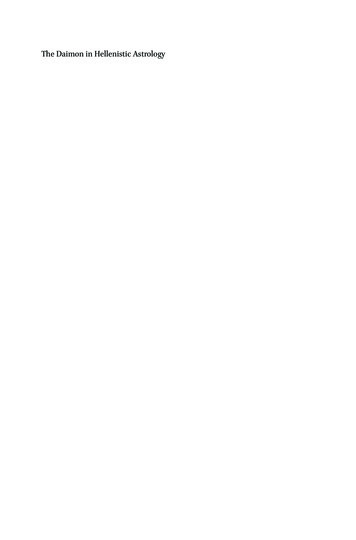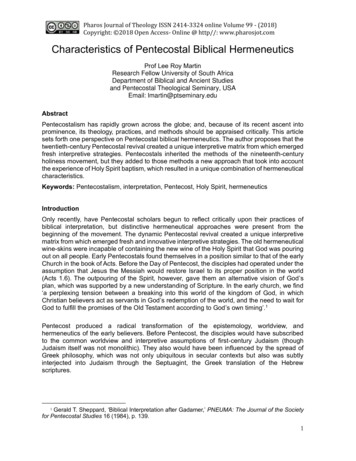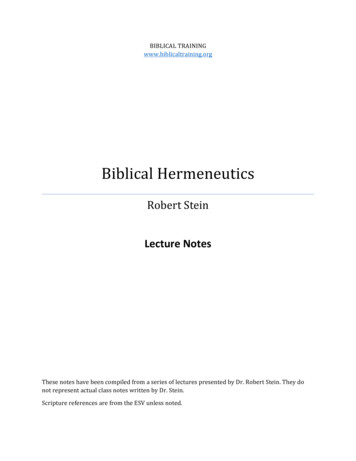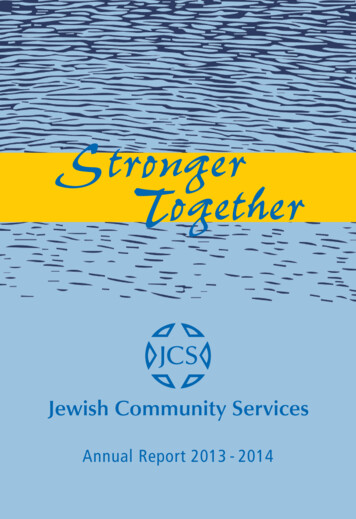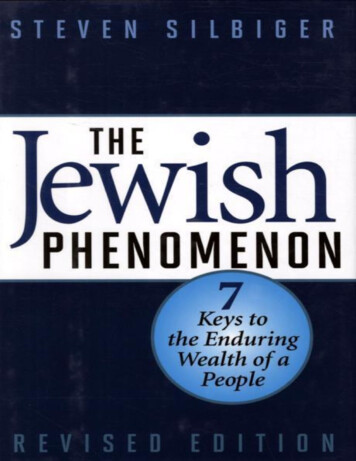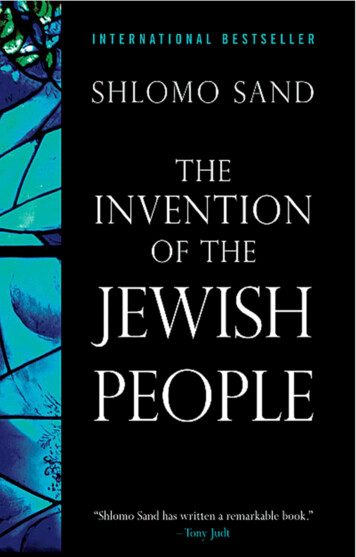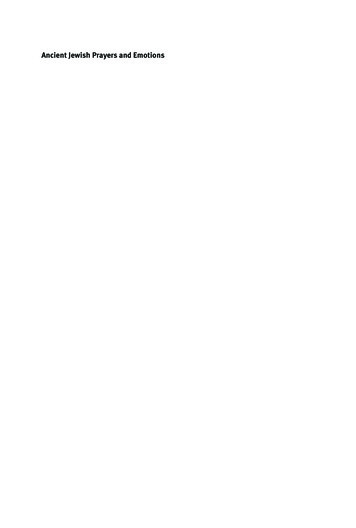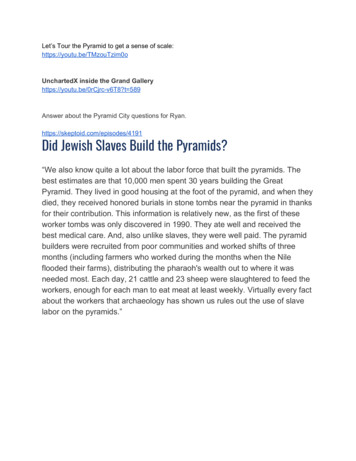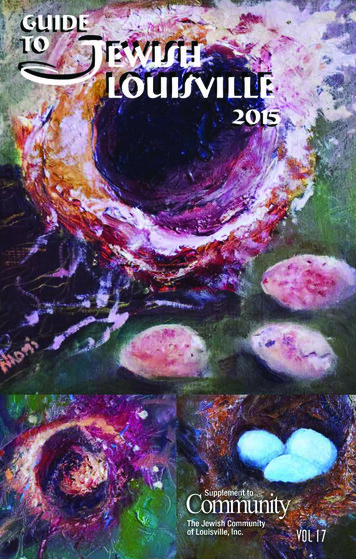
Transcription
Chapter 3Jewish HermeneuticsThere are certain hermeneutical rules for interpretation of the biblical text,usually enumerated according to the order established by Rabbi Ishmael,who formulated thirteen principles for interpretation. --Adin SteinsaltzChapter 2 reviewed aspects of Christian hermeneutics relevant to the interpretation of Isaiah 7:14. It concludedwith a summary of those specific hermeneutical presuppositions and principles adopted by me for this task. Herein Chapter 3 Jewish approaches to the interpretation of the Tanakh (Old Testament) are reviewed. The goal is todetermine where the system of hermeneutics used in this book coincides with, and where it differs from, thevarious hermeneutical practices within Judaism. I argue that the exegetical method used by traditional Jewishscholars, past and present, to determine the ְפּ טָשׁ ט (peshat)--the literal, grammatical meaning of the text--isessentially the same as that used by conservative Christian scholars, past and present. 1EzraEzra is generally recognized as the first interpreter of the Tanakh, specifically the Torah (Five Books of Moses orPentateuch), in the sense in which the word interpreter is used today. Menachem Elon states,The process of exegesis began immediately after the law-giving, since in turning to the Written Law [theTorah or Pentateuch] the halakhic scholars necessarily had to have recourse to various modes ofinterpretation for the purpose of its elucidation and application to the new problems that arose. However,the earliest clear literary references to exegetical activity only date back to the time of Ezra andNehemiah.2Adin Steinsaltz gives additional detail:Ezra, who was a priest and scribe, is the first sage, of all those who studied and interpreted Torah andtaught the people, to be identified by name. It was said of him that he was "a ready scribe in the law ofMoses which the Lord God of Israel had given" (Ezra 7:6), and the task he undertook became themission of all the teachers who came after him. "For Ezra had prepared his heart to seek the law of theLord and to do it and to teach in Israel statutes and judgment" (Ezra 7:10). He was, therefore, theprecursor of the age of the anonymous scribes, the period known in Jewish history as the era of theKnesset Gedolah (the Great Assembly).31The transliteration of the Hebrew into English in this chapter is not entirely consistent. Different sources cited or used asa reference at times use different conventions for transliteration and are in general printed here as in the originalsource. א and ע are sometimes transliterated in the usual way (transliterated at all (e.g., Aboth rather than ’Aboth).23’and‘, respectively) and other times are not פ may be rendered as f or ph, final ת as t or th, and the femininesingular as -a or -ah.Menachem Elon, "Interpretation," EncJudaica, VIII:1416; brackets added.Adin Steinsaltz, The Essential Talmud, trans. Chaya Galai (New York: Bantam Books, 1976), p. 14; italics original. The1
This period corresponds approximately to the period of Persian rule over Judea (ca. 539-332 B.C.). The earlyscribal periods, beginning with Ezra, are reviewed in the following section.The Scribal PeriodsThe SopherimThe sopherim (or soferim) were "a specific class of scholars," beginning with Ezra. 4 According to a number ofscholars: There was an era of the sopherimThese sopherim founded the Great AssemblyThis body enacted numerous traditions and halakhoth.5Other scholars disagree: "Though the Talmud does mention regulations by Ezra and by the men of the GreatSynagogue, it does not attribute any decrees or halakhah to scribes between Ezra and the tannaitic era." 6Moreover, the Mishnah tractate ’Aboth makes no reference to the sopherim or to "generations" of sopherim.Therefore, these scholars conclude that there was no "era" of the sopherim. The word sopher (singular ofsopherim) then, would simply be "a general designation for Torah scholars and copyists from various eras." 7Nevertheless, it remains useful to delimit this period between Ezra and the beginning of the next period (theperiod of the zugoth). The limits are generally taken to be from Ezra to Simeon the Just, "who was the last of theGreat Assembly is also known as the Great Synagogue. A number of Jewish sources link the beginnings of the GreatAssembly to the account in Nehemiah 8-10 (for a list of these sources, see Daniel Sperber, "Synagogue, The Great,"EncJudaica, XV:629).4567Yitzhak Dov Gilat, "Soferim," EncJudaica, XV:79-80. Sopherim (Heb., ) סוְֹפ םיִרםים is the plural of sopher (Heb., ) סוֹרֵפר ,meaning enumerator, secretary, scribe (BDB, p. 708). It is used in the Tanakh many times (e.g., 2 Sam. 8:17; 20:25; 1Kings 4:3; 2 Kings 22:3; 1 Chron. 18:16; Jer. 26:24; 36:11). From Ezra 7:6, 10, 12, Neh. 8:1-8 the word apparently tookon a somewhat different meaning that involved interpreting and teaching the law. According to Gleason L. Archer, Jr., ASurvey of Old Testament Introduction, 2nd ed. (Chicago: Moody Press, 1974), p. 411, based on the assumption that theArtaxerxes in Ezra 1:7 was Artaxerxes I Longimanus (464-424 B.C.), then Ezra's arrival in Jerusalem in the seventhyear of "the king" (7:8) would be 457 B.C.; Nehemiah arrived in the king's twentieth year, or 445 B.C. (Neh. 2:1).Gilat, "Soferim," XV:80. The words halakhah (plural, halakhoth) and haggadah (plural, haggadoth) are defined in thesection "Rabbinic Literature," subsection "Types of Rabbinic Literature" later in this chapter.Ibid.Ibid. This general sense perhaps represents its usage in the Gospels, translated by the Greek γραμματεὐς; see, e.g.,Matt. 2:4; 5:20; 7:29; 9:3.2
men of the Great Assembly."8 Thus the approximate dates, 400 to 200 B.C., are useful to delimit this period. 9Although some scholars deny that a "Great Assembly" ever existed, 10 others except it as historical. However,according to Steinsaltz,The exact nature of the Great Assembly is unclear; it may have been a permanent institution withlegislative and executive powers, or merely the generic name for all the scholars of a given period. Infact, with few exceptions, the names of the sages and outstanding personalities of this age areunknown.11Daniel Sperber makes a similar observation:The institution of the Great Synagogue, or perhaps, more accurately, the Great Assembly, belongs tothat period of Jewish history which is still virtually a complete blank, namely the Persian period. Hence,very little is known of it with real certainty.12According to Steinsaltz, much material had accumulated over the centuries, namely, "oral traditions that includedinterpretations, customs, and legal precedents." 13 The Great Assembly organized this material to facilitatesystematic transmission.14 It also created new ordinances for the Second Temple period (516 B.C. andfollowing). This included regulations governing behavior in many spheres of life. 15In regard to the oral traditions and new ordinances, Hermann Strack, although with some reservations about the8Ibid., XV:79-80. The reason for Ezra as the terminus a quo of this period is that according to Daniel Sperber,"Synagogue, The Great," XV:629, statements he cites from the Talmud, Midrashim, and Targumim make it appear "thattraditionally the idea of the Great Synagogue [Great Assembly] was linked with the narrative in Nehemiah 8-10, whereits earliest beginnings are suggested." The reason for Simeon the Just as the terminus ad quem is that in the Mishnahtractate ’Aboth, he is mentioned as "one of the survivors [or remnants] of the Great Assembly" (Uriel Rappaport,"Simeon the Just," EncJudaica, XIV:1566). However, there is some uncertainty as to his exact identity. One view, goingback at least to Josephus (Ant. 12:43), is that Simeon the Just is Simeon I, a high priest 310-291 B.C. (or possibly 300270 B.C.). Sperber, "Synagogue, The Great," XV:629, argues that the evidence is stronger for Simeon II, 219-199 B.C.It is also possible to extend this period to Antigonus of Sokho, a student of Simeon the Just. Sperber suggests that thestatement in ’Aboth 1:4, that Yose b. Joezer and Yose b. Johanan "received from them" and not "from him," a referencein ’Aboth 1:3 to Antigonus of Sokho, "possibly means that they still received traditions directly from the 'remnants of the910Great Synagogue.'" According to Moshe David Herr, "Antigonus of Sokho," EncJudaica, III:67, "Antigonus representsthe link in the chain of tradition between Simeon the Just, his teacher, and the Zugot."Isidore Epstein, "Talmud," IDB, IV:512, takes the close of the period of the Sopherim to be ca. 270 B.C.Sperber, "Synagogue, The Great," XV:629, cites Keunen.11Steinsaltz, The Essential Talmud, p. 14. The term "sages" (Heb.,12131415 ֲח טָכםיִמםים ) used in this citation is a general term.Ephraim Urbach, "Sages," EncJudaica, XIV:636, writes that the sages were "those men who molded every sphere of lifeof the Jewish people and influenced their comprehension of their past, their hopes, and their future aims. The sagesflourished from the beginning of Second Temple times until the Arabian conquest of the East [A. D. 634 - 750], a periodwhich spanned the days of Hasmonean rule and the sway of Rome and its governors, the Jewish War (66-70/73 C.E.)and the destruction of the Second Temple, the autonomous leadership of the nesi’im, in Erez Israel, and theemergence of a powerful Diaspora both in the Greco-Roman world and in the Jewish center in Babylonia. The termsages embraces the men of the Great Synagogue, the scribes (soferim), members of the Sanhedrin, nesi’im, heads ofthe academies, Pharisees, hasidim, mystics, and haverim."Sperber, "Synagogue, The Great," XV:629.Steinsaltz, The Essential Talmud, p. 15."They are said to have introduced the classification of the Oral Law into three fields of study, that of Midrash (in thebroadest sense of the word), halakhot, and aggadot (TJ, Shek. 5:1, 48c [Jerusalem Talmud, tractate Shekalim])"(Sperber, "Synagogue, The Great," XV:630). These three terms are defined in the section "Rabbinic Literature,"subsection "Types of Rabbinic Literature" later in this chapter. For a brief discussion of the Oral Law, see the section"Rabbinic Literature," subsection "The Oral Torah" later in this chapter.Steinsaltz, The Essential Talmud, p. 15.3
Great Assembly, has this comment:The Law found in the Torah of Moses was the only written law which the Jews possessed after theirreturn from the Bab [Babylonian] exile. This law was neither complete nor sufficient for all times. Onaccount of the ever-changing conditions of life new ordinances became necessary. Who made these wedo not know. An authority to do this must have existed; but the claim made by many that after the daysof Ezra there existed a college of 120 men called the "Great Synagogue" cannot be proved.What was added to the Pentateuchal Torah was for a long time handed down orally, as can be plainlyseen from Jos [Josephus] and Philo.A comprehensive collection of traditional laws was made by Rabbi Akiba c 110-35 AD, if not by an earlierscholar. His work formed the basis of that of the Rabbi Mē’īr, and this again was the basis of the ed[edition] of the Mish [Mishnah] by Rabbi Jehūdāh ha-Nāsī’.16It is beyond the scope of this book to argue the issues involved, but the following working hypotheses areaccepted. The oral "traditions"17 originated for the most part in the period beginning with Ezra.18 These traditions were observed and promoted by the Pharisees 19 and were in the New Testament calledthe "tradition of the elders."20 They were passed on and likely grew in the pharisaical schools of Hillel and Shammai. They were finally codified by Rabbi Judah ha-Nasi (ca. A. D. 200) to form the Mishnah.2116Hermann L. Strack, "Talmud," Old ISBE, V:2905; brackets added. Strack writes in his Introduction to the Talmud andMidrash, (Philadelphia: Jewish Publication Society of America, 1931), p. 9, "We need not, of course, accept the Jewishtraditional opinion that there existed in those early days [from Ezra onward] a body of 120 men called the 'GreatSynagogue,' since it is held by modern scholars quite plausibly that the notion is a pure invention resting on the accountin Neh. 8-10." Concerning the date for Rabbi Meir, it is known that Rabbi Akiba (b. ca. 50) was executed by the Romansat the conclusion of the disastrous Bar Kokhba revolt, which took place from A. D. 132-135. One estimate for RabbiMeir is ca. 110 - ca. 175.17The Hebrew noun for tradition is18192021 ס תֶרת ֹ טָמ ֶר (masoret). It is used only once in the Tanakh, Ezek. 20:37, meaning bond, inthe phrase "bond of the covenant" (BDB, p. 64). According to Leon Yagod, "Tradition," EncJudaica, XV:1309, "In thetalmudic literature, the term masoret is used to include all forms of tradition, both those which relate to the Bible andthose which concern custom, law, historical events, folkways, and other subjects." Legal, binding tradition is given thespecial name halakhah, and the traditions related to the vocalization (vowel points) and punctuation of the Hebrew textis called masorah. Halakhah and haggadah are defined in the section "Rabbinic Literature," subsection "Types ofRabbinic Literature" later in this chapter.See the section "Rabbinic Literature," subsection "The Oral Torah" later in this chapter.The Pharisees were probably the successors of the Hasidim ("pious ones") (see Robert Wyatt, "Pharisees," ISBE,III:826; Matthew Black, "Pharisees," IDB, III:776; Harold W. Hoehner, "Hasideans," ISBE, II:621). The Hasidim played amajor supportive role in the Maccabean revolt (168-165 B.C.) and are mentioned in 1 Maccabees (e.g., 2:42; 7:10-18).The earliest point in history where the Pharisees appear is during the reign of John Hyrcanus I (135-104 B.C.) takingpart in an event referred to by Josephus, Antiquities of the Jews, Book XIII.10.5. See J. E. H. Thomson, "Pharisees,"Old ISBE, IV:2362; Black, "Pharisees," III:779; Wyatt, "Pharisees," III:826; Merrill C. Tenney, New Test
15 Steinsaltz, The Essential Talmud, p. 15. 3. Great Assembly, has this comment: The Law found in the Torah of Moses was the only written law which the Jews possessed after their return from the Bab [Babylonian] exile. This law was neither complete nor sufficient for all times. On account of the ever-changing conditions of life new ordinances became necessary. Who made these we do not know. An .
